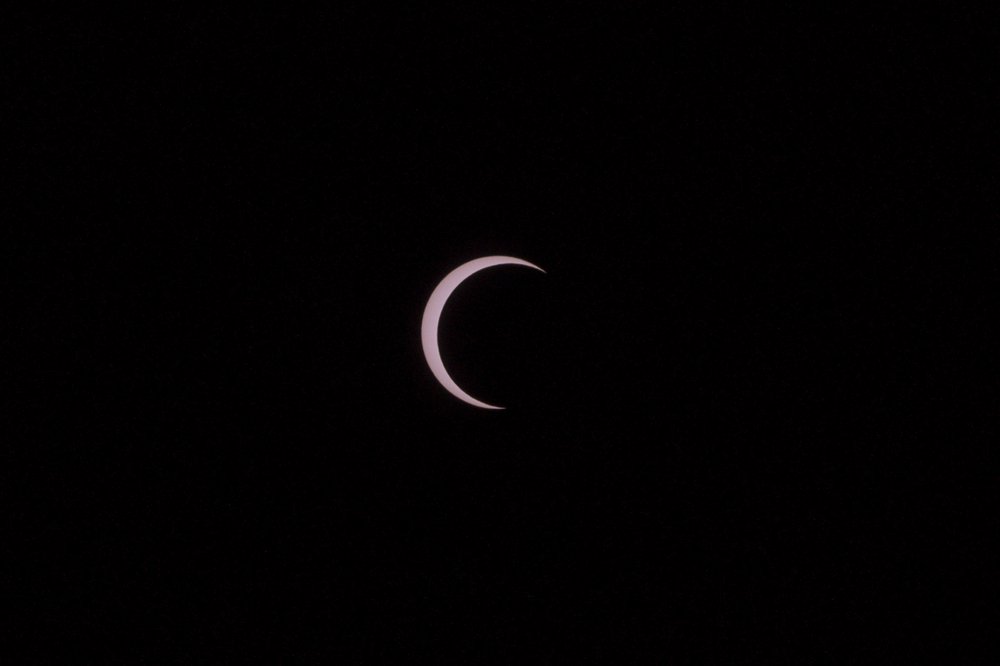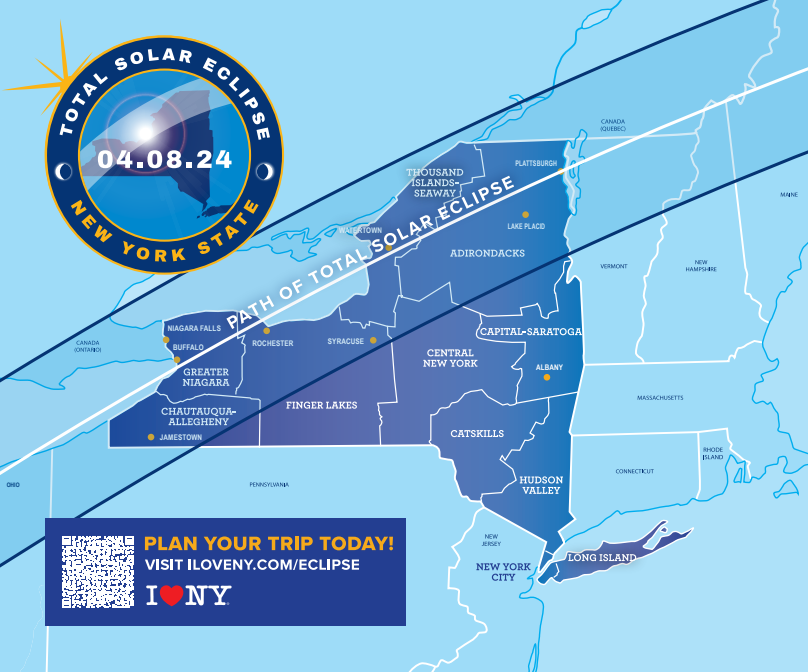Don't miss the April 8 eclipse in NYC. It won't happen again until 2044.
March 10, 2024, 11:01 a.m.
About 90% of the sun will be obscured by the moon.

New Yorkers need only look up — with eye protection — on the afternoon of April 8 for a view of the biggest celestial event of the year: a solar eclipse.
At 2:10 p.m., the moon will begin to cover the sun. By 3:25 p.m., about 90% of Earth’s closest star, which is roughly 93 million miles away, will be obscured. At that moment, the sun will appear as a bright crescent clinging to the dark edge of the black disc of the moon. The whole show will last about two and a half hours. While New Yorkers will need to head upstate for a total eclipse, the view should still be spectacular in New York City.
The last eclipse was in 2017. The next eclipse visible from the city will be in 20 years.
“I don't think that there is another astronomical phenomenon that I could encourage you to go to that could inspire you to your core the way a solar eclipse can,” said Jackie Faherty, an astrophysicist at the American Museum of Natural History on the Upper West Side. “If you're watching at the beginning, it's nothing, and then all of a sudden in comes the moon, moving at a nice beautiful clip, and it starts to look like the Death Star from 'Star Wars' across the face of the sun.”

Where to watch the eclipse
Parks, waterfronts and roofs are prime areas for a great view. There are also eclipse events across the city, including at the American Museum of Natural History, Green-wood Cemetery and the New York Hall of Science. Free solar glasses will be available and telescopes will be set up to give visitors a close-up view of the eclipse. Experts will also be on hand to answer questions.
“If you can see the sun, you can watch the event unfold in New York City," Faherty said. "So just don't put yourself deep into the concrete jungle of Midtown, where there's way too many tall buildings that could block the sun for you."
The sky won’t go completely black, because 10% of the sun is bright enough to make it look like it’s another hazy day. But the change will be dark enough to confuse animals whose biological clocks are tuned to the sun.
“Nocturnal animals and even non-nocturnal animals will regularly go into their night mode,” said Faherty. “Frogs will start chirping their night time songs. Birds will go to roost.”
How to watch the eclipse safely
Time to dust off those solar glasses from 2017. If you can’t find them, it’s a good idea to buy another pair. They are selling fast — and are absolutely necessary. Looking directly at the sun can cause permanent eye damage.
Solar glasses are available at camera shops, including Adorama and B&H. The American Academy of Ophthalmology provides a recommended list of brands and vendors. The group advises against purchasing solar eyewear from Amazon due to counterfeits. One red flag is “approved by NASA” branding, because the agency does not do product endorsements.
“There are some old wives' tales about ways to look at the sun if you don't have those [solar viewers], but those are not trustworthy,” said Bart Fried, executive vice president of the Amateur Astronomers Association. “When that happens, you're in deep trouble. And it's not a reversible process, it can lead to blindness.”
The Solar Eclipse Activities for Libraries program offers free eclipse glasses at public libraries, so you can check your local branch or the StarNet website for availaibilty.
If solar eclipse glasses are hard to come by, the Amateur Astronomers Association recommends using a welder’s shield with No. 14 glass. Another option is an indirect viewing method, such as a homemade pinhole projector. Instructions are available on NASA’s website.
Binoculars and telescopes with solar filters can offer a deeper look at what’s happening on the sun’s surface. Sun spots, which look like clusters of black dots with the unaided eye, are magnetic storms on the sun. With a telescope, sky watchers can see the dark center of those spots surrounded by a penumbra with little silvery filaments on its edge.
“It's literally stunning in its beauty, these silvery filaments and the glow around the sun with the dark background," Fried said. "It’s just magical."
Want to see a total blackout?
New York City is not in the path of totality for this solar eclipse. That means the moon will not completely block out the sun and create the “diamond ring effect,” which makes the moon appear as a black disc surrounded by a glowing halo.

If New Yorkers want to go all out, they’ll need to head north. The closest destination in the path of totality is Syracuse — about a four-hour drive away — or the Adirondacks, a little farther away. Rochester has planned a three-day eclipse festival. But be warned, hotels and Airbnbs are largely booked up.
New Yorkers who stay put will still have a spectacular view, provided the weather cooperates.
“I'm most excited about sharing it with my family who live here, sharing it with my friends who live here, sharing it with the people from around the city,” said astronomy buff and Upper West Side resident Ryan Khan.
Khan said he plans to set up solar telescopes and binoculars on Pier I in Riverside Park along the Hudson River. He’ll have extra eclipse viewers to share and will be listening to the sun with antennas plugged into his computer. The radio waves from the sun sound like a loud humming.
NASA Just Released Absolutely Amazing Eclipse Photos Taken From Space